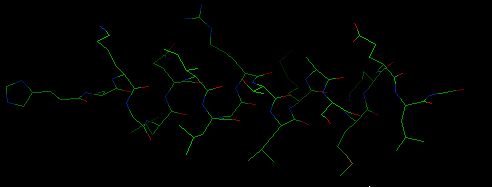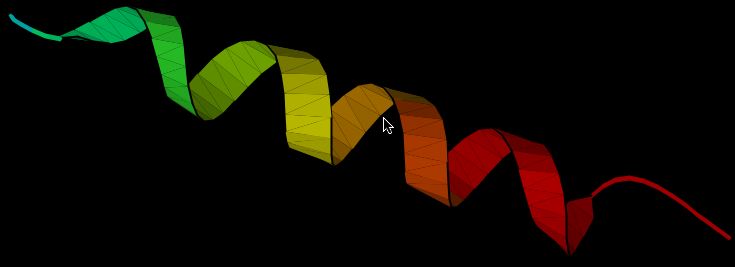

Figure 1. This is a detailed image of the atoms on the amino acid sequence of the alpha subunit of the voltage-gated potassium channel. Each color signifies a different atom in the sequence. The Shaker gene in Drosophila encode for this ion channel. This is the display option under webmol on the given PDB webiste for the Shaker protein (http://www.pdb.org/pdb/explore.do?structureId=1HO2)

Figure 2. This is another image of a segment of the membrane bound alpha subunit voltage-gated potassium channel encoded by the Shaker gene. This is the display option under KiNG on the given PDB webiste for the Shaker protein (http://www.pdb.org/pdb/explore.do?structureId=1HO2)
Scientific Article: Reduced sleep in Drosophila Shaker mutants (view abstract of article by Cirelli et al., 2005 April 28; 434: 1087-1092) (All information in this section assumed to be from scientific article)
The article in Nature states that some animals use sleep to maintain the homeostatic nature of the body efficient function. Previous studies have shown in both humans and animals that there are genetic components to sleep, but the details are unclear thus far. The article states that there are some similarities between fruit flies and mammals sleeping patterns and development such as function capacity decreases with lack of sleep, flies will sleep longer after a highly active day to compensate, there are neural changes in the brain during sleep, and younger flies sleep longer and more often.
In the study they narrowed down their mutant sample population so only the line E1174 or mns on the X chromosome was changed from wild type. This mutation was characterized as recessive with the phenotype in both sexes as sleeping 4-5 hours, while wild type and heterozygous fruit flies of both sexes slept 9-12 hours per day. Researchers manipulated the flies sleeping patterns by depriving them of the length of time they could sleep and then evaluated their motor activity, response to stimulus and heat, and their overall lifespan. Overall the mns flies changes in activity and in compensatory sleep after deprivation were significantly smaller than the normal flies indicating that mns flies don’t need as much sleep for normal function. An angle the article brought to light for why mns flies had reduced changes in ability to function is that they slept more efficiently than the other genotypes.
The researchers then molecularly characterized this mutant line on the Shaker gene and through variety of genetic analysis looked at the Shaker (Sh)+ locus the mutation causes both the shaking legs and minisleep phenotypes. The shaker locus encodes for the alpha-subunit of a potassium channel for the repolarization of the neuronal cell membrane. The researchers sequenced the DNA of the entire Shaker gene coding region. The different isoforms of the Shaker gene share a common core domain in the protein. When they sequenced the mns flies they found that there was a single point mutation changing threonine to leucine on one coding segment. The high conservation among a wide range of species of the threonine residue suggests high weight for the resulting protein’s function. The article adds that while this one mutated gene might play a role in the short sleeping trait, there could be others that contribute to the trait. They do believe that this Sh+ has a powerful effect on the voltage potassium channels, and is optimistic towards future research looking at sleep and sleep therapies at the cell level.
Popular Press: Losing Sleep: Mutant flies need less shut-eye (view article in Science News Online by Christen Brownlee, 2005 April 30; 160: 275) (All information in this section assumed to be from popular press article)
The popular press article from Science News Online titled “Losing Sleep: Mutant flies need less shut-eye” summarizes the article in Nature by Cirelli et al. titled “Reduced sleep in Drosophila Shaker mutants” in language suitable for public understanding. The article states that previous research has found similarities in sleeping patterns between fruit flies and humans. Both species have a group of individuals in the population that require less hours of sleep to function normally than a normal individual. In fruit flies Cirelli and his team termed these individuals minisleep flies or mns flies. The researchers at the University of Wisconsin-Madison observed a large number of mutant phenotype and normal phenotype flies adjusting their sleeping patterns and then evaluating their capacity to function regularly. The mns flies were able to function normally under the stringent sleeping patterns while the normal flies showed slower reaction times to stimuli.
The reason for the difference that the researchers found between the two groups of fruit flies was a single mutation on the Shaker gene on the X chromosome. The article stated that the Shaker gene expresses for other phenotypes, such as the shaking of the flies’ legs when the flies wakes up from anesthesia. Cirelli and his colleagues believe that the mns flies cannot sleep the typical length of time because they have overly excited neurons related the affects the mutation has on neuronal membrane channels. Science News recognized that the researchers also found that the mns flies had a shorter lifespan by 2 weeks compared to the normal lifespan of the wild type flies and ended the article with how the researchers implied the importance of sleep on life.
Critique:
While the popular press successfully summarizes the sleep deprivation and evaluation of motor activity and stimuli response portion of the study well, it left out some other aspects. The popular press article seems to focus on the observed differences in the study between the wild type and the mns flies at the species level. The article does state briefly that the changes on the Shaker gene in the mns flies affect neural membrane channels. The Nature article goes deeper than these visual observations and looks at the nucleic and amino acid sequences differences between the wild type and mns flies. The article then describes the effect of the change in polarity on the ion channel. One possible reason for the complete deletion of this part in the Science News article is the author’s need to account for the public’s background knowledge in molecular biology. Instead of wasting valuable text lines explaining ion channel hydrophobic and hydrophilic nature and how individual amino acids can alter this structure and function, the author simply removes this material and states the end result. The scientific article is able to mention this amino acid sequencing and ion channel characteristics because these authors are writing for other scientists. They can assume a baseline of knowledge that a popular press author cannot match. One can see this difference in the use of vocabulary in the two different articles and how without a baseline of knowledge, a random reader of the Nature article would be lost.
Another difference between the two articles is their implications of the finding of a short-sleeper gene. The popular press article says in the beginning that the mutated gene is found in both humans and insects, which can reduce an insect’s sleep two thirds of the normal length of time. The popular press article never states that there could be other contributing genes or factors that could aid in this trait in addition to the mns gene. On the other hand the Nature scientific article states that they found other lines of flies with different mutations showing the short-sleeping phenotype, but they were not as severe as the mns line. The article also explains that it is possible that repolarization membrane regulation might be the leading part of the sleep process, but it never states that it is the only factor. The Nature article authors state relationships between the potassium channels, the signal transduction pathway, and sleep in mammals, but don’t correlate their findings with the Drosophila flies. They only just suggest that the structures and mechanisms are similar. While the popular press article is trying to intrigue the reader and keep them reading, the scientific article authors must be careful with their implications of their findings. They did not prove that sleep is controlled by one gene nor did they find the sleep gene in flies or humans. They clearly stated the facts and where research will be directed in the future.
One interesting similarity between the two articles was that both brought up the implication of the correlation between sleep and life longevity. The researchers in the Nature article looked at how the mns line flies lifespan was affected by the decrease in sleep and found they lived 2 weeks less than the non-mutated flies. The popular press article ended by commenting on how these results support previous evidence on the body. Other scientific articles such as one by Van Dongen et al. looks at the cumulative effect of sleep deprivation. The public and the scientific world share this theme of what keeps us alive longer and what shortens it. Looking at these two articles, while subtle, shows the common theme of interest.
Popular press articles reach a wider range audience than scientific journals, but are restricted by space and must keep the interest of the readers, thus affecting the article's content and word choice. One can see that it is better to use the original article in the scientific journal if the reader has the necessary resources and knowledge on the subject. Reading a popular press article reviewing a separate article might lose important information in translation and could carry the author's bias. In conclusion, it is best to read popular press articles with caution and not to take for gospel.
Refernces:
Cirelli et al. 2005 April 28. "Reduced sleep in Drosophila Shaker mutants". Nature. 434: 1087-1092.
"Losing Sleep: Mutant flies need less shut-eye" 2005 April 30. Science News Online. <http://www.sciencenews.org/articles/20050430/fob2.asp> Accessed 2006 Sept 11.
Protein Data Bank: 2006 Sept 12. NMR structure of the potassium channel fragmenet L45 in micelles: webmol & KiNG Display options.<http://www.pdb.org/pdb/explore.do?structureId=1HO2>. Accessed 2006 Sept 12.
Van Dongen et al. 2003. "The cumulative cost of additional wakefulness: dose response effects neurobehavioral functions and sleep physiology from chronic sleep restriction and total sleep deprivation". Sleep.26: 117-126.
For more information, please refer to the
Davidson College Genomics Home Page
Davidson College Biology Home Page
E-mail me any comments or concerns
© Copyright 2006 Department of Biology, Davidson College,
Davidson, NC 28035